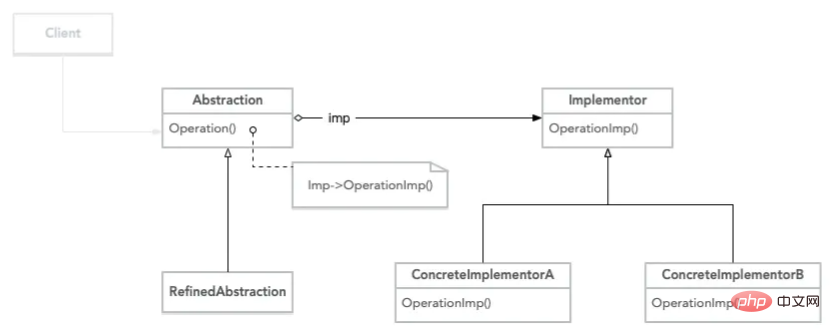A brief discussion on the bridge mode in PHP
In the previous article "Let’s talk about the memo mode in PHP" we introduced the memo mode in PHP. The following article will take you to understand the bridge mode in PHP design pattern.

Bridge mode, in the programming world, is actually synonymous with combination/aggregation. Why do you say that? We who are familiar with object-oriented all know the benefits of inheritance. Subclasses can share many attributes and functions of the parent class. However, inheritance also brings a problem, that is, serious coupling. Modifications of the parent class will have an impact on subclasses to some extent. Even a modification of a method or attribute may require all subclasses to modify it. This violates the principle of open encapsulation. Bridging is to solve this problem. It emphasizes the use of combination/aggregation to share some available methods. I believe you must have thought of traits in PHP. If you have used this feature at work, then you have already used bridge mode!
Gof class diagram and explanation
GoF definition: Separate the abstract part from its implementation part so that they can change independently.
GoF class diagram

##Code implementation
interface Implementor
{
public function OperationImp();
}
class ConcreteImplementorA implements Implementor
{
public function OperationImp()
{
echo '具体实现A', PHP_EOL;
}
}
class ConcreteImplementorB implements Implementor
{
public function OperationImp()
{
echo '具体实现B', PHP_EOL;
}
}abstract class Abstraction
{
protected $imp;
public function SetImplementor(Implementor $imp)
{
$this->imp = $imp;
}
abstract public function Operation();
}
class RefinedAbstraction extends Abstraction
{
public function Operation()
{
$this->imp->OperationImp();
}
}$impA = new ConcreteImplementorA(); $impB = new ConcreteImplementorB(); $ra = new RefinedAbstraction(); $ra->SetImplementor($impA); $ra->Operation(); $ra->SetImplementor($impB); $ra->Operation();
- In the source code explanation, we will find that this mode is very similar to the adapter mode. However, the purpose of an adapter is to help two unrelated classes work together to achieve intermediate conversion work. The purpose of bridging is to decouple the inheritance of method behavior, easily add, modify, and dynamically call behaviors, so that the abstract interface and implementation parts can be changed independentlyso that the abstract interface and implementation parts can be changed independently This means that as long as the reference to the implementation interface is maintained, the specific implementation class of our implementation interface can be a completely different class with different functions and can be changed arbitrarily. Let the implementation decide what it is. Advantages of the bridge mode: sharing interfaces and their implementation parts, improving scalability, and making implementation details transparent to customersThe main problem solved by the bridge mode is caused by the continuous growth of inheritance Tight coupling problemComposition and aggregation: Aggregation is a weak relationship, A can contain B, but B is not part of A; combination is a strong relationship, A contains B, B is also a part of A, the relationship between the whole and the part
Our mobile phones have different models, and each model produces roughly the same but different accessories. For example, X1 mobile phone case, film, and earphones; X2 mobile phone case, film, and earphones, etc. Due to cost issues, we will not produce completely different accessories for each model of mobile phone. Instead, try to use external universal accessories (Implementor), so that each model of mobile phone (Abstraction) can be combined (Bridge) and sold to consumers. In this way, our mobile phone brand will not run out of financing and close down too early. It seems that there are really many correlations between running a business and learning design patterns! !
Full code: https://github.com/zhangyue0503/designpatterns-php/blob/master/18.bridge/source/bridge.php
Example
Our SMS sending can also be implemented using bridging. Suppose we have a lot of text message templates, and then use different text message providers to send text messages. At this time, we can use the bridge mode to form various combinations.SMS sending class diagram
Full source code: https://github.com/zhangyue0503/designpatterns-php /blob/master/18.bridge/source/bridge-message.php<?php interface MessageTemplate { public function GetTemplate(); } class LoginMessage implements MessageTemplate { public function GetTemplate() { echo '您的登录验证码是【AAA】,请不要泄露给他人【XXX公司】!', PHP_EOL; } } class RegisterMessage implements MessageTemplate { public function GetTemplate() { echo '您的注册验证码是【BBB】,请不要泄露给他人【XXX公司】!', PHP_EOL; } } class FindPasswordMessage implements MessageTemplate { public function GetTemplate() { echo '您的找回密码验证码是【CCC】,请不要泄露给他人【XXX公司】!', PHP_EOL; } } abstract class MessageService { protected $template; public function SetTemplate($template) { $this->template = $template; } abstract public function Send(); } class AliYunService extends MessageService { public function Send() { echo '阿里云开始发送短信:'; $this->template->GetTemplate(); } } class JiGuangService extends MessageService { public function Send() { echo '极光开始发送短信:'; $this->template->GetTemplate(); } } // 三个短信模板 $loginTemplate = new LoginMessage(); $registerTemplate = new RegisterMessage(); $findPwTemplate = new FindPasswordMessage(); // 两个短信服务商 $aliYun = new AliYunService(); $jg = new JiGuangService(); // 随意组合 // 极光发注册短信 $jg->SetTemplate($registerTemplate); $jg->Send(); // 阿里云发登录短信 $aliYun->SetTemplate($loginTemplate); $aliYun->Send(); // 阿里云发找回密码短信 $aliYun->SetTemplate($findPwTemplate); $aliYun->Send(); // 极光发登录短信 $jg->SetTemplate($loginTemplate); $jg->Send(); // ......Copy after loginExplanation
This is an aggregation mode. Templates are not part of SMS sending. We can send them directly without using templates. They have no strong relationship.
- The SMS sending method does not need to be changed. You only need to pass in different SMS templates to implement various templates. Quickly send
- When you are not sure whether it must be an is-a relationship, it is more recommended to use a combination/aggregation design method such as bridge mode. If it is determined that the current class relationship is is-a, Then don’t hesitate to use inheritance
Recommended learning: "PHP Video Tutorial"
The above is the detailed content of A brief discussion on the bridge mode in PHP. For more information, please follow other related articles on the PHP Chinese website!

Hot AI Tools

Undresser.AI Undress
AI-powered app for creating realistic nude photos

AI Clothes Remover
Online AI tool for removing clothes from photos.

Undress AI Tool
Undress images for free

Clothoff.io
AI clothes remover

Video Face Swap
Swap faces in any video effortlessly with our completely free AI face swap tool!

Hot Article

Hot Tools

Notepad++7.3.1
Easy-to-use and free code editor

SublimeText3 Chinese version
Chinese version, very easy to use

Zend Studio 13.0.1
Powerful PHP integrated development environment

Dreamweaver CS6
Visual web development tools

SublimeText3 Mac version
God-level code editing software (SublimeText3)

Hot Topics
 1664
1664
 14
14
 1423
1423
 52
52
 1317
1317
 25
25
 1268
1268
 29
29
 1246
1246
 24
24
 Explain JSON Web Tokens (JWT) and their use case in PHP APIs.
Apr 05, 2025 am 12:04 AM
Explain JSON Web Tokens (JWT) and their use case in PHP APIs.
Apr 05, 2025 am 12:04 AM
JWT is an open standard based on JSON, used to securely transmit information between parties, mainly for identity authentication and information exchange. 1. JWT consists of three parts: Header, Payload and Signature. 2. The working principle of JWT includes three steps: generating JWT, verifying JWT and parsing Payload. 3. When using JWT for authentication in PHP, JWT can be generated and verified, and user role and permission information can be included in advanced usage. 4. Common errors include signature verification failure, token expiration, and payload oversized. Debugging skills include using debugging tools and logging. 5. Performance optimization and best practices include using appropriate signature algorithms, setting validity periods reasonably,
 Explain late static binding in PHP (static::).
Apr 03, 2025 am 12:04 AM
Explain late static binding in PHP (static::).
Apr 03, 2025 am 12:04 AM
Static binding (static::) implements late static binding (LSB) in PHP, allowing calling classes to be referenced in static contexts rather than defining classes. 1) The parsing process is performed at runtime, 2) Look up the call class in the inheritance relationship, 3) It may bring performance overhead.
 What are PHP magic methods (__construct, __destruct, __call, __get, __set, etc.) and provide use cases?
Apr 03, 2025 am 12:03 AM
What are PHP magic methods (__construct, __destruct, __call, __get, __set, etc.) and provide use cases?
Apr 03, 2025 am 12:03 AM
What are the magic methods of PHP? PHP's magic methods include: 1.\_\_construct, used to initialize objects; 2.\_\_destruct, used to clean up resources; 3.\_\_call, handle non-existent method calls; 4.\_\_get, implement dynamic attribute access; 5.\_\_set, implement dynamic attribute settings. These methods are automatically called in certain situations, improving code flexibility and efficiency.
 PHP and Python: Comparing Two Popular Programming Languages
Apr 14, 2025 am 12:13 AM
PHP and Python: Comparing Two Popular Programming Languages
Apr 14, 2025 am 12:13 AM
PHP and Python each have their own advantages, and choose according to project requirements. 1.PHP is suitable for web development, especially for rapid development and maintenance of websites. 2. Python is suitable for data science, machine learning and artificial intelligence, with concise syntax and suitable for beginners.
 PHP in Action: Real-World Examples and Applications
Apr 14, 2025 am 12:19 AM
PHP in Action: Real-World Examples and Applications
Apr 14, 2025 am 12:19 AM
PHP is widely used in e-commerce, content management systems and API development. 1) E-commerce: used for shopping cart function and payment processing. 2) Content management system: used for dynamic content generation and user management. 3) API development: used for RESTful API development and API security. Through performance optimization and best practices, the efficiency and maintainability of PHP applications are improved.
 PHP: A Key Language for Web Development
Apr 13, 2025 am 12:08 AM
PHP: A Key Language for Web Development
Apr 13, 2025 am 12:08 AM
PHP is a scripting language widely used on the server side, especially suitable for web development. 1.PHP can embed HTML, process HTTP requests and responses, and supports a variety of databases. 2.PHP is used to generate dynamic web content, process form data, access databases, etc., with strong community support and open source resources. 3. PHP is an interpreted language, and the execution process includes lexical analysis, grammatical analysis, compilation and execution. 4.PHP can be combined with MySQL for advanced applications such as user registration systems. 5. When debugging PHP, you can use functions such as error_reporting() and var_dump(). 6. Optimize PHP code to use caching mechanisms, optimize database queries and use built-in functions. 7
 The Enduring Relevance of PHP: Is It Still Alive?
Apr 14, 2025 am 12:12 AM
The Enduring Relevance of PHP: Is It Still Alive?
Apr 14, 2025 am 12:12 AM
PHP is still dynamic and still occupies an important position in the field of modern programming. 1) PHP's simplicity and powerful community support make it widely used in web development; 2) Its flexibility and stability make it outstanding in handling web forms, database operations and file processing; 3) PHP is constantly evolving and optimizing, suitable for beginners and experienced developers.
 Explain the match expression (PHP 8 ) and how it differs from switch.
Apr 06, 2025 am 12:03 AM
Explain the match expression (PHP 8 ) and how it differs from switch.
Apr 06, 2025 am 12:03 AM
In PHP8, match expressions are a new control structure that returns different results based on the value of the expression. 1) It is similar to a switch statement, but returns a value instead of an execution statement block. 2) The match expression is strictly compared (===), which improves security. 3) It avoids possible break omissions in switch statements and enhances the simplicity and readability of the code.





